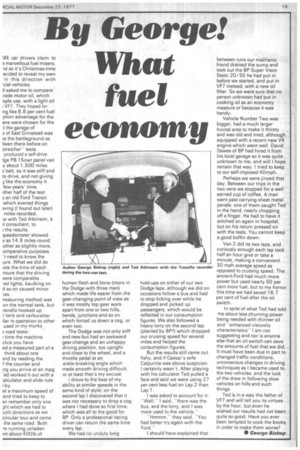By George!
Page 21

If you've noticed an error in this article please click here to report it so we can fix it.
at fuel
ME car drivers claim to a marvellous fuel misers, ld as it's Christmas-time ecided to reveal my own in this direction with -cial vehicles.
il asked me to compare fade motor oil, which ople use, with a light oil ; VF7. They hoped for ng like 6.8 per cent fuel ption advantage for the ans were chosen for the the garage of
s of East Grinstead was )s the battleground as been there before on stretcher.' tests. produced a self-drive lge PB 15cwt panel van y about 1,500 miles 3 belt, so it was stiff and to drive, and not giving like the economy it few years' time.
rther half of the test 3 an old Ford Transit which evened things )ving (I found out later) miles recorded.
re with Ted Atkinson, a il consultant, to the results. Teedometer showed 3as 14.9 miles round other as slightly more, :omparative purposes 't need to know the lure. What we did do lote the time of each nsure that the driving were comparable.
-ed lights, baulking on d so on caused minor neasuring method was on the normal tank, but ransflo hooked up
3 tank and carburetter ilar in operation to other used in my murky, 3 road tester.
time the machine click you have ed a measured part of a think about one
3nd by reading the f the counter and ng you arrive at an mpg -ed worked it out with a :alculator and slide rule et a maximum speed of and tried to keep to 3 n remember only one )ht which we had to 3oth directions as we circular tour and came the same road. Both re running unladen )rn about 400Ib of
human flesh and bone (more in the Dodge with three men) which made life easier from the gear-changing point of view as it was mostly top gear work apart from one or two hills, bends, junctions and so on which forced us down a cog, or even two.
The Dodge was not only stiff and new but had an awkward gear-change and an unhappy driving position, too upright and close to the wheel, and a throttle pedal at an ankle-breaking angle which made smooth driving difficult: or at least that's my excuse.
I drove to the best of my ability at similar speeds in the same kind of style; on the second lap I discovered that it was not necessary to drop a cog where I had done so first time, which was all to the good for BP. Only a professional racing driver can return the same time every lap.
We had no unduly long hold-ups on either of our two Dodge laps, although we did on occasions follow a bus and had to stop ticking over while he dropped and picked up passengers, which would be relfected in our consumption figures. We also followed a heavy lorry on the second lap (planted by BP?) which dropped our cruising speed for several miles and helped the consumption figures.
But the results still came out fishy, and if Caesar's wife Calpurnia was above suspicion I certainly wasn't. After playing with his calculator Ted pulled a face and said we were using 27 per cent less fuel on Lap 2 than Lap 1.
I was asked to account for it. "Well," I said, -there was the bus, and the lorry, and I was more used to the vehicle."
"Hmrnm," they said, "You had better try again with the Ford."
I should have explained that between runs our mechanic friend drained the sump and took out the BP Super Visco Static 20/50 he had put in before we started, and put in VF7 instead, with a new oil filter. So we were sure that no person unknown had put in cooking oil as an economy measure or because it was handy.
Vehicle Number Two was bigger, had a much larger frontal area to make it thirsty and was old and tired, although equipped with a recent new V4 engine which went well. David Dawes of BP had hired it from his local garage so it was quite unknown to me, and will I hope remain that way. I tried to keep to our self-imposed 40 mph.
Perhaps we were jinxed that day. Between our trips in the two vans we stopped for a well earned cup of coffee. A man went past carrying sheet metal panels: one of them caught Ted in the hand, nearly chopping off a finger. He had to have it stitched on again in hospital, but on his return pressed on with the tests. You cannot keep a good boffin down.
Van 2 did its two laps, and curiously enough each lap took half an hour give or take a minute, making a convenient 30 mph average speed as opposed to cruising speed. The ancient.Forcl had much more power but used nearly 50 per cent more fuel, but to my horror this time we had saved 16.7 per cent of fuel after the oil switch.
In spite of what Ted had told me about less churning power being needed with thinner oil and -enhanced viscosity characteristics" I am not suggesting and nor is anyone else that an oil switch can save the amounts of fuel that we did. It must have been due in part to changed traffic conditions, unconscious changes in driving techniques as I became used to the two vehicles, and the luck of the draw in following slow vehicles on hills and such things.
Ted is in a way the father of VF7 and will tell you its virtues by the hour, but even he wished our results had not been quite so good. Have you ever been tempted to cook the books in order to make them worse?
• George Bishop




































































